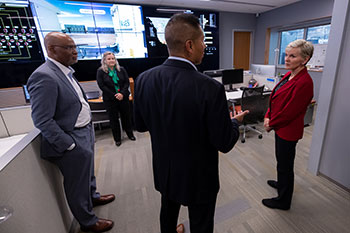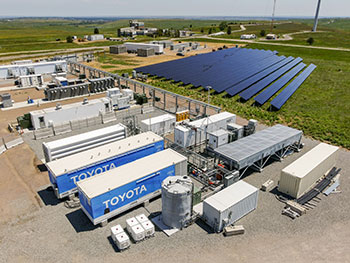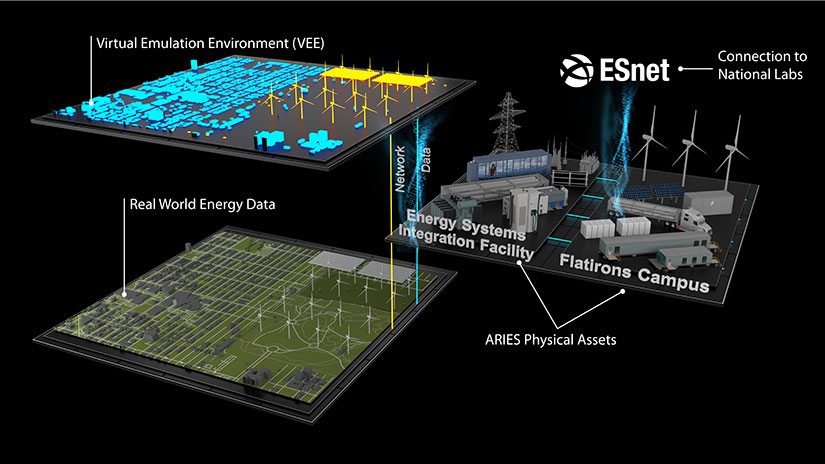Capabilities
Advanced Research on Integrated Energy Systems (ARIES) is a visionary research platform that crosses multiple energy sectors, scales, and technologies. It integrates physical and virtual capabilities to address complex energy systems integration challenges.

The Three Pillars of ARIES
ARIES comprises three pillars networked together to provide an interconnected and scalable research platform: the Energy Systems Integration Facility (ESIF) at NLR's South Table Mountain Campus; the Flatirons Campus, which allows us to work at higher voltages and scales; and the Virtual Emulation Environment, which amplifies the platform further. The Virtual Emulation Environment is powered by Kestrel, NLR's 44-petaflop supercomputer, and allows us to study system sizes and configurations that go beyond hardware capabilities.

The Energy Systems Integration Facility at NLR's South Table Mountain Campus houses an unparalleled collection of state-of-the-art capabilities and technologies—including hundreds of research devices—to study energy technologies at scales up to 2 MW and voltage levels up to 13.2 kV. ESIF laboratories offer:
- Hardware-in-the-loop up to 2 MW
- A research electrical distribution bus that comprises two AC and two DC ring buses, is easily and quickly configurable, and connects multiple sources of energy, loads, and plug-and-play components
- Supervisory control and data acquisition systems to monitor and control the research electrical distribution bus operations, safety, and resilience and gather real-time, high-resolution data for collaboration and visualization
- A high-performance computing data center that offers peta-scale computing for large-scale numerical modeling
- Data analysis and visualization tools that allow researchers and partners to see and understand complex systems and operations in a completely virtual environment
- The ARIES Cyber Range allows researchers and partners to study energy systems' interaction with and dependence on digital technology. Within the new Energy Security and Resilience Lab, partners and researchers can access an integrated suite of ARIES capabilities including the cyber range, grid analysis tools, and diverse physical assets for power-hardware-in-the-loop evaluations to visualize all-hazards simulation scenarios and answer grid security and resilience questions at scale.
- A test bed to evaluate advanced distributed management systems, distributed energy resource management system, and other controls utilities and operators need for managing the evolving grid
- A microgrid research platform with advanced grid assets that can be networked and reconfigured to validate diverse microgrid applications

The Flatirons Campus hosts hardware and simulation capabilities that support experiments for thousands of research devices, power levels up to 20 MW, and voltage levels up to 34.5 kV and represents the interface between the distribution and bulk power systems. Flatirons Campus assets offer:
- Hardware-in-the-loop up to 20 MW
- Medium-voltage (13.2-kV) research grid infrastructure that allows selected assets to be interconnected on an isolated, stand-alone grid; on an emulated grid; or with the utility
- 2 controllable grid interfaces, a 7-MW and 20-MW, that allow for multiple experiments at one time and can create a customized, controllable research grid with diverse grid conditions and emulation capabilities isolated from the utility grid
- A hydropower emulation platform
- Devices and system infrastructure, including:
- Grid integration research pads with power connections up to 4 MW each
- Electrical switchgear, metering, and data acquisition equipment to connect devices to the utility grid, research grid, and other assets
- Wind turbine and photovoltaic solar technology in various sizes
- A megawatt-scale energy storage system and load bank
- A custom medium-voltage data acquisition system that includes dozens of real-time, global positioning system-synchronized, modular measurement nodes located at all power devices and strategic electrical interconnection points across the site
- Hydrogen capabilities that include a 1.25-MW proton-exchange membrane electrolysis system, 600-kg ground storage system, hydrogen compressor, Toyota 1-MW proton exchange membrane fuel cell generator, and 3.7-MW integrated cooling system that allow partners and researchers to create, store, and use hydrogen in a full grid environment
- For a full list of ARIES capabilities at Flatirons Campus, download the map.

The Virtual Emulation Environment is a sophisticated digital platform that can incorporate physical assets at both the ESIF and Flatirons Campus with millions of emulated devices at any utility power and voltage level, from local- to national-scale
research. To understand the behavior of large systems, it is necessary to extend beyond the physical assets at ESIF and Flatirons Campus. Enabled by the state-of-the-art high-performance computing capabilities at NLR, ARIES can scale up these devices
to virtually represent a community or region. Coupled with the advanced visualization environment, an in-depth exploration and analysis capability emerges that includes:
- Digital real-time simulators: These simulators are key to emulating thousands of power grid devices, creating precise digital twins of real-world environments at real-time steps. This capability supports a broad range of research and development activities, enabling thorough system analysis and validation across various energy systems. The ARIES digital real-time simulators cluster (connected racks) is the largest in the R&D environment.
- Controller hardware-in-the-loop: This provides scalable controller emulations, enabling the study of energy system behavior under various conditions.
- The ARIES Cyber Range: This simulates cyber-physical systems and networks, extending hardware-in-the-loop practices to include digital communications and cybersecurity.
- High-performance and quantum computing interfaces: These are pivotal for enhancing artificial intelligence and machine learning algorithms and handling the complexity of vast technological ecosystems.
- The Virtual Emulation Environment is further amplified by connectivity to the U.S. Department of Energy (DOE) Energy Sciences Network, which connects ARIES with other national laboratories and industry partners.
What Makes ARIES a Unique National Asset
- State-of-the art research equipment to support integrated energy research, analysis, modeling, and hardware experiments at various scales, including six research pads, an advanced distribution management system test bed, ARIES Cyber Range, the microgrid research platform, the Power Electronic Grid Interface, 7- and 20-MW controllable grid interface, digital real-time simulators, and behind-the-meter storage
- A 44-petaflop high-performance computer to break through existing limitations and achieve metropolitan- and regional-scale research resolution
- The ability to create, prove, and validate complex energy systems by interconnecting hardware and software that imitate energy configurations and systems solutions
- Interconnected grid-scale devices and distributed energy resources for highest-fidelity experimentation
- A team of national laboratory experts with a depth and breadth of knowledge in energy systems integration and innovation at the leading edge nationally and internationally
- Ability to interconnect to an increasingly diverse pool of assets at partner organizations through DOE's ESnet to form SuperLab 2.0
- A virtual emulation environment that allows for emulation at a scale unlike any other and validation of energy technologies with higher confidence
Share
Last Updated Dec. 30, 2025
